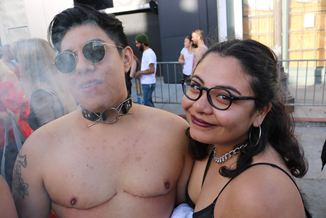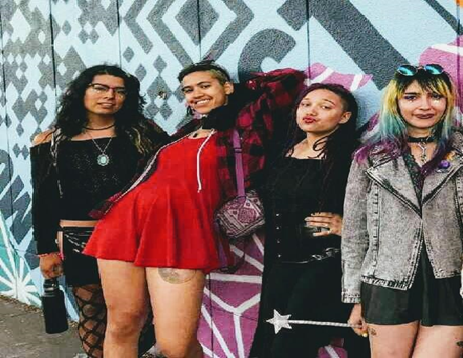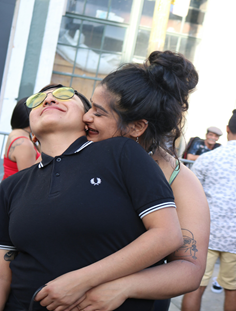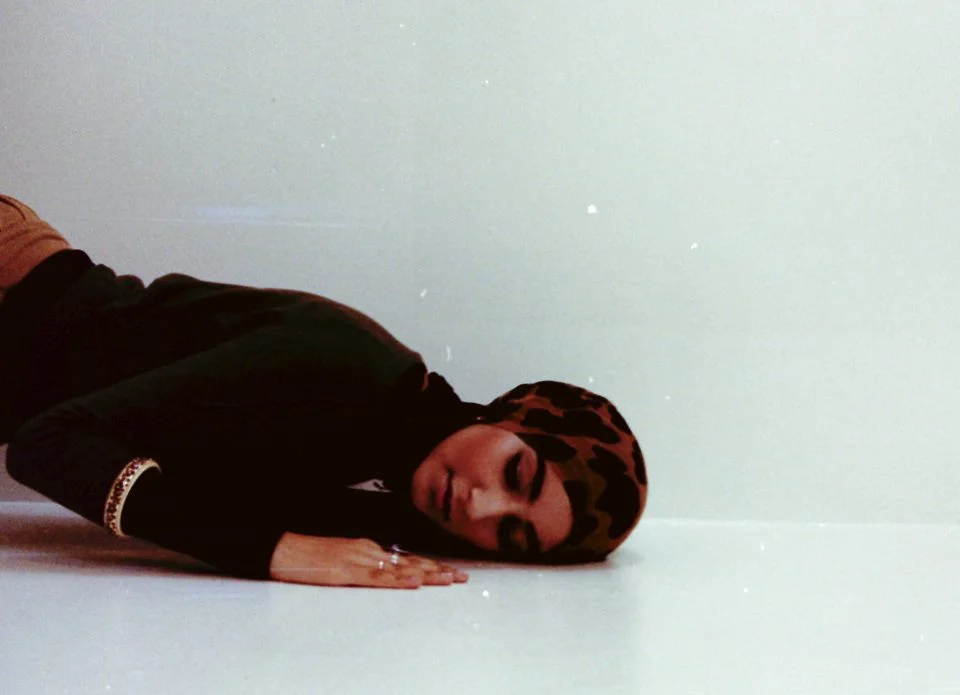Pictured: London Leo Dominguez & Cristal Ibana Bonilla
Photography: Madhvi Trivedi-Pathak
Fall has dawned, and summer shenanigans are calming tf down. Or at least it seems like that as I wear a scarf, and hope this 80-degree weather in San Francisco will literally chill out and remind itself it’s fall. I’m pulling on the ends just a little too tight, choking myself a bit.
I happened to think of the Folsom Street Fair and the ways it’s been a fixture in San Francisco since September 23rd, 1984. (Yes, I was reminded of Folsom Street Fair because I choked myself a lil.)
The festival started as a safe haven for folks with alternative sexualities and fetishes to walk around in broad daylight, sometimes with their genitals out. Some folks would be shocked to find out there are people who enjoy BDSM even when there isn't a huge festival going on.
Pictured: The author with Izel Diaz
Photography: Madhvi Trivedi-Pathak
As a short, brown (and chubby and delicious) gender non-conforming queer who’s been to Folsom Street Fair in the past, I was still in awe at how the majority of folks look like the images I was taught were allowed to be alternatively beautiful. Insert images of pale, thin, moody industrial goths, reminiscent of 1997's Fifth Element here, taking up space all over.
From white cis lesbians with problematic dreads towering over me, to bulging white cis men (known by QTPoC as “Castro Clones”), the abundance of whiteness highlights ery specific image of what kink looks like in San Francisco, setting the standard around the world. The city is known as a place of free love and innovative expressions of identity, as well as techie companies such as Airbnb, Lyft and Twitter. To me, this is all just really good branding.
As a result of all the rampant and stressful displacement of multiply marginalized Queer and Trans people of color, I made it my goal for the event to create pockets of resistance with the QTPoC I saw at Folsom Street Fair. Whether I knew them or not, it was a means for all of us to feel safer. With this task in mind, and with my collar and leash on, I set out with my handler and our crew. To be honest, I would probably be affiliated with any other QTPoC group at Folsom, either through social justice organizing, my roommates, school homies, my heauxin, or a cousin – let's be real.
What if I told you that many Black, Brown, Indigenous, Asian and countless other folks of color find healing in kink? More specifically, that QTPoC have deep relations and love for kink and are very much invested in kink communities. At the same time, we endure a lot of racial microaggressions within kink communities as a result of unchecked privileges. Why do we attend events that aren't made with us in mind? Am I just a jaded heaux? Is there healing to be found in kink communities for people of color? And if things are so fucked up there, why do we keep going? I knew my answers, but wanted community input, so I asked . . .
Pictured: Leeloo Levay, Gaia Weise, Mz. V & Zed
Photography: Hablo Rodriguez-Williams
London Leo Dominguez: “When I moved to San Francisco, I witnessed heavy amount of gentrification, which has made my advocacy for QTPoC inclusion within white spaces stronger. [I work to create] environments that let folks know we're here together, [which] gives other QTPoC the comfort to flourish. As far as Folsom Street Fair goes, seeing QTPoC families flaunt their beauty unapologetically brings joy to my heart.”
“For many, QTPoC events like Folsom greatly inspire the emergence of underground communities that have already existed. The trust within one another to feel free and safe has encouraged more and more pockets of beauty and melanin to assert space at Folsom. Arriving at events as groups allows QTPoC to be unapologetic about literally taking up space.” (anonymous)
Pictured: Rexy Amaral
Photography: Hablo Rodriguez-Williams
Rexy Amaral: “Growing up I never liked my body. In my teens I felt like I was too fat. This year I've started to love my body and I wanted to show how much I loved it.
"As someone who's always trying to fight for inclusion and celebration of minorities, I love to show up to a predominately white space and look sickening so that other QTPoC feel empowered to be high femme and not be ashamed of their appearance."
Pictured: Anmol Singh & Ebony Ortega
Photography: Madhvi Trivedi-Pathak
Anmol Singh: “I think Folsom centering kink is healing as hell! [It's great to] have all the control in the world, whether as a sub, Dom, or somewhere in the middle. From never having a say with power dynamics – sexually, materially, economically, politically – there's hella trauma around powerlessness that kink helps us work through.”
Pictured: Leeloo Levay
Photography: Hablo Rodriguez-Williams
Leeloo Levay: “I went because I like the vibe and healing space [created] through nudity. It's about all the things you wonder about the things you don't see and you look at them. Because you're coming to see the strange because we are strange and we want to belong.”
Izel Diaz: “I've been involved in BDSM for a few years, and I've attended Folsom as a submissive, as a dominant, and on my own. I initially joined BDSM as a means to bring some physicality to the pain that I carried with me. Through BDSM, though, I found a lot of tenderness in aftercare and respect for the energy I exchange and the trust that goes into each scene.
"I went to Folsom this year solely as my puppy's handler and to experience a white-centered space a a cadre of glorious QTPoC folks. I also feel it's important to leverage my masculine-of-center presentation and dominant energy to carve out space for the folks I care about.”
* * *
With a myriad of reasons for QTPoC to be present within kink communities, it’s a matter of whether or not we are welcomed with authenticity or as a result of performative allyship. Do we branch off and create our own play parties filled with melanin, ropes and paddles? Do we say fuck it and move on? Or do we continue supporting each other as we have for eons? All I gotsta say is: Do you boo and don't let nobody get in the way of you living your life.
For there to be growing groups of QTPOC taking up space at places such as Folsom, play parties, creating their own play parties, and having their own year-round arrangements with other kinksters, I mean, there must be something magical to all this. We are here, and we are healing by taking up more space through kink.
Edited by Eli Sleepless
We need community support to continue publishing!
Articles and artwork like these are only possible through your contributions. Please donate today to sustain the wellbeing of artists, writers, healers, and LGBTQ2IA+ people of color.
You can also support our team by picking up a Rest for Resistance print zine.
Image descriptions:
One: Two brown queer people stand side by side. The person on the left is wearing a black studded O-ring choker and aviator style glasses with no shirt and visible top surgery scars has their black hair slicked back and is blowing smoke with their face angled away from the camera. The second person is smiling, wearing dark pink lipstick, black round glasses, large hoop earrings, a silver chain necklace, and a black tank top. Their dark brown wavy hair is clipped back and their eyebrows are arched and filled in.
Two: Two brown queer people are standing in a crowd, smiling. The person on the right is holding a leash attached to the other person's collar. They are wearing a black tank top, black glasses, and black jeans with medium-length hair pulled back, and their visible arm has several tattoos. The person on the left has short dark hair and bright pink lipstick. They're wearing a black bra, black shorts, black tights, and a backpack.
Three: Four QTPoC stand against a light blue wall with black geometric patterns painted on to it. All are smiling and posing for the camera. Notably, one wears a bright red dress and one holds a star shaped fairy wand!
Four: A brown queer femme poses sensually over a sidewalk grate. Looking straight at the camera their fully made up face displays confidence. Their right arm rests at their side while their left is drawn up to their mouth, where their fingers rest between their bright red lips. Their left leg is bent forward and they wear strappy silver heals and a see through black mesh unitard. Pink triangular pasties cover their nipples and a black purse rests over the crook of their left arm.
Five: A brown queer person with thick long black hair in a top bun hugs another person from behind. They have a tattoo of a skull on their upper left arm and are pressing their nose and lips into the neck of the qtpoc in front of them. The brown queer person being hugged has a big smile on their face and is arching their head back, welcoming the contact of the other's lips. They have on a black polo shirt with white accents and lightly tinted sunglasses.
Six: A brown queer person stands shirtless and takes a selfie from an upward angle. They are squinting behind their red rimmed glasses and brush back their medium length black hair with their left hand which has a rose tattooed on it. They are wearing a silver metalic backpack and a blue pendant lays at the center of their chest suspended by a bronze chain around their neck.
About Hablo Rodriguez-Williams:
Hablo Rodriguez-Williams is a genderqueer, chubby faggotty, femme, living with multiple disabilities, brown boi and Virgo. They are extremely giggly and awkward, manifesting what they desire through a compassionate fiery nerd rage. Hablo's work has been published in the Huffington Post; Mills College 580 Split; The oldest Chicana/o/x literature blog, La Bloga; and Rooted in Rights.





















Lighting candles, burning sage, going to therapy, accessing medication, praying, giving offerings to the ancestors have all been ways that I heal at the intersections of my beautifully complex existence.